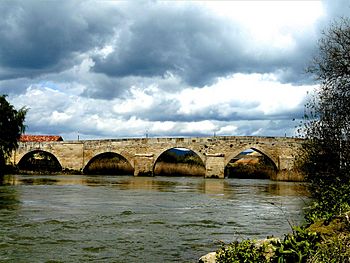Zadorra facts for kids
Quick facts for kids Zadorra |
|
|---|---|

The Zadorra at Armiñon
|
|
| Country | Spain |
| Physical characteristics | |
| Main source | Basque Mountains 1,045 m (3,428 ft) |
| River mouth | Ebro River |
| Length | 78.1 km (48.5 mi) |
| Basin features | |
| Progression | Ebro→ Mediterranean Sea |
| Basin size | 1,361.28 km2 (525.59 sq mi) |
The Zadorra is an important river in the Basque Country, a region in northern Spain. It is a tributary of the larger Ebro River. The Zadorra flows mostly through the Álava province, except for a small part in La Puebla de Arganzon. It then joins the Ebro River near Miranda de Ebro.
The Zadorra is the largest river in Álava. Its river basin covers the biggest area in the province. Today, the Zadorra provides water for Vitoria, a major city, and about half of the Basque Autonomous Community. This is done through a system of reservoirs like Uribarri-Ganboa, Urrunaga, and Albina.
The river begins high up in the Entzia Plateau. It starts at a spring called Los Corrales. From there, it winds its way across the Alavan Plains. It flows west, looping around Salvatierra/Agurain, and then passes Vitoria to the north. After Vitoria, it turns south to meet the Ebro River.
Cool Places Along the Zadorra River
- The village and old castle of Gebara are located by the river. You can find them in the middle part of the Zadorra's journey.
- The Zadorra Reservoir System starts at Uribarri-Ganboa. These reservoirs were built starting in 1947 to help manage the river's water.
- A famous historical event, the Battle of Vitoria, happened along the Zadorra. This battle took place over an 18-kilometer (11-mile) stretch of the riverbanks. It went from La Puebla de Arganzon to Trespuentes and Mendoza.
- The ancient Basque-Roman town of Iruña-Veleia is also located across the river from Trespuentes.
Protecting the Zadorra River
The Zadorra is a very important river for Álava. Like many rivers near cities and industries, it has faced challenges with pollution. It has been one of the rivers in the Basque Country with higher levels of pollution.
Many years ago, a lot of waste was allowed to be put into the river. This waste came from cities and factories. Sometimes, waste was even dumped without permission. This caused problems for the river's health.
The amount of oxygen in the Zadorra became too low for the animals living in the river. There were also some harmful substances found in the water. To fix this, many wastewater treatment plants were built. These plants help clean the water before it goes back into the river. The types of insects found in the river can also tell us how healthy the water is. If certain insects are missing, it means the river might still need more help.
In 2008, a report looked at the Zadorra river's health over four years. It showed that the pollution levels were too high. Because of this, local towns started programs to control waste. These efforts have helped to reduce pollution in the river. People are working hard to make the Zadorra cleaner and healthier for everyone.
See also
 In Spanish: Río Zadorra para niños
In Spanish: Río Zadorra para niños

